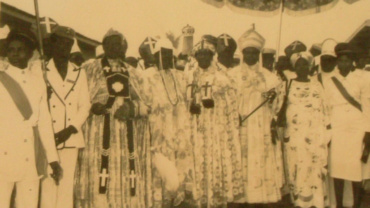In the early years of Ayetoro, long before brick halls and wooden chambers were constructed, the Apostles often gathered beneath a simple thatched pavilion. Made from palm fronds, bamboo poles, and the labour of their own hands, this modest shelter became one of the most important spaces in the life of the Happy City. It was here that prayers were offered, disputes settled, and the vision of a new kind of community was shaped.
The pavilion stood close to the shoreline, its open sides allowing the sea breeze to pass through as waves provided a steady background rhythm. Under its shade, the Apostles sat in white garments, their staffs of authority laid before them. Archival photographs capture the striking simplicity of the scene: rows of men and women seated on wooden benches, the roof of palm thatch arching above, sunlight streaming through the gaps. Oral testimonies recall how the sound of hymns rose with the rustle of palm leaves, blending nature and worship into a seamless harmony.
Meetings under the thatched pavilion followed a rhythm that combined spirituality with governance. Proceedings began with prayer and the singing of hymns, reaffirming that all decisions were to be made under divine guidance. Matters of importance were then brought forward: how to allocate fishing grounds, how to maintain walkways and bridges, how to respond to challenges facing the community. Every voice was given respect, and elders often paused for long silences, believing that truth emerged when speech was measured and prayerful.
One of the most memorable assemblies held in the pavilion was the early discussion about building the Power House in 1959. The Apostles weighed the bold idea of electrifying the town through communal labour and resources. Though it seemed ambitious, the decision was reached collectively, demonstrating the pavilion’s role as the birthplace of some of Ayetoro’s most defining initiatives.
Beyond governance, the pavilion served as a school of values. Younger members were invited to observe the meetings, learning by watching the patience and humility of the elders. Oral accounts recall how children would sit quietly at the edges, their eyes wide as they witnessed decisions that shaped their daily lives. In this way, the pavilion was not only a chamber of leadership but also a classroom of communal wisdom.

Visitors to Ayetoro in the 1950s and 1960s were often struck by the sight of the Apostles gathered under such a humble roof. To them, it seemed remarkable that a town admired as “Small London” conducted its most important affairs not in grand halls but beneath a simple structure of palm fronds. Yet to the Apostles, the pavilion was entirely fitting. It embodied their values: simplicity, humility, and reliance on God rather than worldly display.
Though the original pavilion has long been lost to the encroaching sea, its memory endures in photographs and oral traditions. To remember it is to recall the spirit of Ayetoro itself — a people bound not by walls or wealth, but by shared faith and the conviction that true strength rests in unity.




